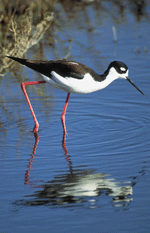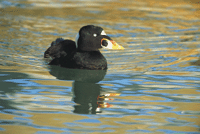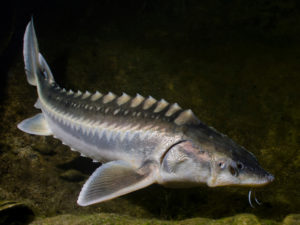At 60 days old, you can swim effortlessly in frigid water, buoyed by the insulating envelope of air beneath your feathers. Your parents are gone, and you paddle among others like you, as many as the mountain peaks that rise in the distance. You bide your time, feeding in the clear waters of the lake by diving and overturning stones to reveal the caddis flies, bugs, and worms hiding beneath. Many evenings you fly with the other fledglings, making curving circuits over the lake. The days are becoming shorter, and a kernel of longing is growing within you.
One day your flight with the other ducklings begins at dusk and does not end on the lake’s surface. Instead, you climb into the glowing blue sky, orient yourself to the angle of the light, and turn south. You fly in an irregular group with the others, ascending out of reach of earthbound sound until only the whistling of wings fills your ears. You climb until the story of the Earth unfolds beneath you, sinuous black rivers reflecting white moonlight, and dark forests giving way to bare mountainside.
Eventually you spy the silver-tinged blackness of the ocean spreading westward. The flock begins to follow the sometimes jagged, sometimes curving coastline.
A pattern develops. The sun rises and the flock feeds and rests in coastal waters; the sun sets and the flock takes off once again on its journey. After days of effort, a large lake-like body of water comes into view.
The flock descends, following the cliffs and rocks of the shoreline that dimple into the east. You pass over a brilliant orange twin-peaked structure that juts across the entrance to the bay. To the south, sharp angles and clean lines in tones of white and gray gleam in the morning sun. To the north, and on the distant east shore, soft hills flow down to the water.
Inside the bay, wide swaths of mudflats exposed by the low tide rim the shore, and small birds have settled there, as numerous as fallen leaves. Many curling, branching slough channels meander through the green marshes, where the white plumage of waterbirds flecks the waterways.
Farther on, you look down on meandering channels interspersed with row upon row of rectangular ponds, ranging in hue from yellow-green to purplish-red. Bird life is abundant below: Ducks and other birds are scattered across the glassy surface of many ponds, and shorebirds roost anyplace there is dry dirt. Yet you shun the dense vegetation of the narrow marshes, the shallow geometric ponds, and the pungent smell of decay that rises to your nostrils. Instead you turn back toward the salt air of the open bay and continue flying, ever lower, until everywhere beneath you lie blue-gray waters lightly ruffled with whitecaps. The flock alights near other diving ducks, on water ten body lengths deep; afloat, once more, in a medium as familiar as air. Here clams are plentiful in the sandy bottom, and mussels grow on every rocky outcrop. Here you can rest, and access to the open ocean is not far away. Here you will spend the winter. Here an instinctual longing is fulfilled. You have finally arrived at the protected waters of San Francisco Bay.
- Surf scoter (adult male). Photo by Alan Justice.
Surf scoters are sea ducks, so named for their habit of “scoting,” or diving through the trailing side of waves while feeding. Although scoters frequent nearshore ocean habitats during the winter, they are also dependent on the sheltered waters and abundant prey of estuarine environments such as San Francisco Bay.
Surf scoters are among the least studied of North American waterfowl. Completely indigenous to North America, they breed in summer across northern Canada and Alaska and winter on the Pacific coast from southeast Alaska to Baja California and Sonora, Mexico. Surf scoters are common in the Bay and along the California coast from October to May.
What little is known about surf scoter migration indicates considerable complexity, with males, females, and young migrating at different times. About three weeks after the female initiates incubation on the breeding ground, the male will leave and go to a molting ground, an inshore area where thousands of scoters congregate. After the eggs have hatched, females protect their young and lead them to plentiful feeding grounds in nearby lakes. Most females abandon their young before they reach flight age, at about 55 days. Females then proceed to molting or staging areas; the young are left to find their way south for the first time without the guidance of adults.
Scoters account for about 20 percent of all wintering waterfowl in San Francisco Bay. Of these, surf scoters comprise the great majority; white-winged and black scoters are extremely uncommon. The Bay may be the most important inshore habitat for this species in the eastern Pacific, south of Puget Sound. In 1990 the Bay held 38 percent of the Pacific Flyway’s midwinter scoter population.
Unlike other diving ducks commonly found on San Francisco Bay (including scaup, canvasbacks, and ruddy ducks), scoters rely almost exclusively on open waters, rarely visiting salt ponds or marshes. Scoters also tend to dive deepest, to depths between 2 and 10 meters when foraging, with forays lasting up to 30 seconds. They feed primarily on bottom-dwelling shellfish and crustaceans, such as clams, mussels, and crabs.
Their feeding preferences may be putting the scoters at risk…
* * * * *
Thirty-two hours have passed since your first young one hatched, and now the fourth speckled egg is splitting, wet feathers bursting from the shell. Four more hours and all the downy chicks have dried. You carefully remove the broken eggshells, whose insides glare conspicuous and white against the dun-colored earth. You walk to the edge of the island and drop the shells in the shallow salt pond, away from the searching eyes of potential predators. The sun is high in the sky; the air is still. It is time to make the crossing.

- Adult black-necked stilt, Palo Alto Baylands. Photo by David Weintraub.
Your ruby-colored legs wade into the water and you call, an insistent and harsh monosyllabic note, to the young ones. They walk awkwardly to the island’s edge, stumble into the brine, and swim with difficulty in water four inches deep toward the steep pond edge. You keep one watchful eye on your young, another on the sky, scanning for the broad wings that signal the low-flying predator.
The young ones have struggled over the levee that separates pond from marsh. Still you beckon to them, and they follow you into the welcoming damp-earth tangle of salty plants, invisible now to the low-flying predator that hunts from above. Under cover of the marsh plants, they rest.. Eventually, you and your mate will lead them back out into the open—risking ravenous eyes—to gorge on shrimp and flies in the salt-heavy pond.
A little over a month ago, you rediscovered your favorite nest site and chose a mate. Now, with your young hidden in the pickleweed, hunger prompts you to return to the salt pond, where you peck at tiny brine flies near the surface and sweep your bill back and forth through the water to catch deeper prey.
When the menacing silhouette of a hawk floats toward your territory, you respond with staccato calls to the chicks, who freeze where they are. You run to the pond’s edge and fake brooding, a protective crouching movement that indicates your young are hidden safely beneath you. In this way, you trick the hawk into hunting elsewhere.
The black-necked stilt is dependent on the present variety of habitats within the Bay throughout its life cycle. A stilt chick will often begin its life in a shallow nest scrape or stick nest situated on a salt pond “island” or levee, although nests in ponded tidal marsh habitat are also common. After the last (usually fourth) egg of the nest has hatched, parent stilts will lead their flightless chicks away from the nest toward a safe haven with enough cover to shield them from predators, such as the northern harrier.

- Black-necked stilt and nestlings, Palo Alto Baylands. Photo by David Cardinal/Cardinal Photo.
For the next several weeks, chicks will feed and mature under the watchful eyes of their parents, moving between the cover of the marsh and the superabundant food source of the salt ponds. The close proximity of salt ponds and salt marsh in the South Bay is probably a key factor in supporting the largest black-necked stilt breeding population along the west coast of the U.S., estimated at approximately 600 pairs in 2001…
One of only five shorebird species that regularly breed in the San Francisco estuary, stilts are largely absent as breeders along the coast north of San Francisco Bay. In the early 1900s, however, stilts may not have bred at all in Northern California coastal wetlands. They began to appear in small breeding groups around managed salt ponds in the Bay during the 1940s, presumably when their Central Valley wetland habitats began to disappear. Their local numbers increased steadily, and by 1981 some 600 to 650 pairs were breeding in South Bay salt ponds alone.
The ranks of resident black-necked stilts swell during fall and winter when migrants from inland areas arrive. Black-necked stilts are short- to medium-distance continental migrants, moving from sites in the U.S. to Mexico and Central America, with prolonged stops at sites along the way. Ninety percent of the more than 17,000 stilts wintering in U.S. Pacific coast wetlands do so in the Bay.
Your movements are stealthy, your coloring is cryptic, and your bill and feet are caked with mud. You travel silently and urgently along the ground, hardly rustling a stem of the pickleweed that surrounds you. You are returning from the muddy slough banks exposed at low tide, where you pried snails from the stems of cordgrass, pursued erratic salt marsh flies, and gobbled tiny crustaceans scratched from the soft ground. You hop up into the branches of the gumplant and settle once again onto the round, woven cup of the nest, shaded from above and on all sides by leaves and flowers. You take care to place your featherless brood patch directly against the three pale-blue-and-brown-speckled eggs. Your belly is full, and you are content to sit, quietly warming the eggs for the next half hour until hunger once again drives you off the nest for a few precious minutes to search for food.
Your mate has begun singing nearby, but suddenly the rich buzzing notes transform to a piercing high timbre. Alarm surges through your veins. In the same split second you hear it: the raspy cry of the crow. Your piercing calls match those of your mate as the entire nest shrub vibrates.
In the next instant, you are face to face with a large black eye and an enormous black bill. You rocket from the nest.
You and your mate cry shrilly, hop madly from shrub to shrub, and scold incessantly. You watch helplessly as the sleek predator deftly pierces each eggshell, gulping down the contents. The crow departs as precipitously as it arrived.
You return to the broken shards of your nest. Failed, for the second time in a row. Your mate flies closer, clearly showing his attractive breast spot and yellowish belly. You peer at him. Time to start over again.
To the diminutive Alameda song sparrow, south San Francisco Bay is the entire universe. Although song sparrows are the most diverse and widespread songbird in North America, only 3 out of 52 subspecies are endemic to salt marshes, and each (Alameda, Samuel’s, and Suisun) is found in San Francisco Bay. Subspecies designations are often scientifically disputed, but DNA analyses indicate that the Alameda song sparrow is the most genetically distinct of the three. Uniquely adapted to survival in a salty environment, the Alameda song sparrow is found only in the 10 percent of fragmented tidal marsh habitat that currently remains in the South and Central Bay, from San Francisco on the western side to El Cerrito on the eastern side.
As a year-round resident, this subspecies is spared the annual exertions of migration. The trade-off is the need to rely on a restricted home range for feeding all year, and more intense predation from creatures who regularly dine on locals’ eggs and young. Pressure from predators generally increases when habitat is fragmented, as it is here in the Bay.
Despite such hardships, Alameda song sparrows will renest as many times as possible from early March to late July in an attempt to raise offspring to independence; researchers have documented up to seven attempts by a single pair. Some ingredients of success for an Alameda song sparrow include a territory that encompasses a portion of slough edge—coveted terrain for gleaning seeds, snails, amphipods (small crustaceans), and insects. In some of the South Bay’s largest remnants of tidal marsh, preserved primarily within the Don Edwards San Francisco Bay National Wildlife Refuge, many finely branching slough channels contribute to high densities of 16 birds per hectare, three times the density observed in less favorable habitat.
Recent studies indicate that the planet’s total population of Alameda song sparrows is between 12,000 and 18,000. Without an increase in high-quality habitat, this subspecies could be at risk of extinction.
It is now springtime, and you are forsaking the bay. You take off with 30 other stilts, leaving behind your familiar roosting spot on sun-warmed ground surrounded by salt ponds. The land of freshwater marshes and rivers to the northeast is beckoning you. Below you, the buzzing trill of song sparrows wafts up from the cordgrass. You pass over open blue water where scoters have paired off, each male defending a territory around his mate. A huge flock of sandpipers flashes in the distance, their liquid movement finally settling along the mud at bay’s edge.
With effort, persistence, and a little luck, you will return next fall with your family group. And if luck deserts you, then perhaps your mate or the young ones will make the trek back. As long as the bay and its varied habitats remain, your kind will return to its welcoming shores.

.jpg)



